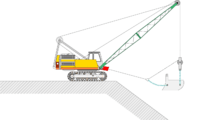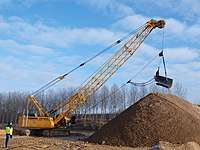dragline excavator
English
WOTD – 27 December 2017
Pronunciation

An illustration of a dragline excavator

A Liebherr HS 835 dragline excavator
- (Received Pronunciation) IPA(key): /ˈdɹæɡlaɪn ˈɛkskəˌveɪtə/
- (General American) IPA(key): /ˈdɹæɡlaɪn ˈɛkskəˌveɪtɚ/, /-ɾɚ/
Audio (AU) (file) - Hyphenation: drag‧line ex‧ca‧vat‧or
Noun
dragline excavator (plural dragline excavators)
- Any of several very large vehicles used for lifting, especially in the process of mining: basically an excavator which drags its bucket to fill it.
- 1940, J. B. Mertie, Jr., “Economic Geology”, in The Goodnews Platinum Deposits, Alaska (United States Department of the Interior, Geological Survey Bulletin; no. 918), Washington, D.C.: Government Printing Office, OCLC 883337479, page 61:
- In mining with a dragline excavator, the upper half to two-thirds of the alluvium contains too little of the previous metals to warrant washing; hence this part of the overburden is lifted by the excavator and dumped to one side of the cut.
- 2003, “Earthmoving Machinery”, in Wendy Horobin, editor, How It Works: Science and Technology, volume 5, 3rd edition, Tarrytown, N.Y.: Marshall Cavendish, →ISBN, page 703, column 2:
- A dragline excavator has a large cutting bucket suspended from the end of a boom. The operator first lowers the bucket mouth down where earth is to be removed, then a second cable—the dragline—pulls the bucket across the surface. The weight of the bucket and the pull of the dragline make a blade at the mouth of the bucket dig into the topsoil, filling the bucket as it moves. When the bucket is full, its contents are tipped by lifting and inverting the bucket over a waiting dump truck. Dragline excavators are particularly useful in strip mining, where they remove the overburden or topsoil.
- 2008, Douglas C. McVarish, American Industrial Archaeology: A Field Guide, Walnut Creek, Calif.: Left Coast Press, →ISBN:
- An alternative to the power shovel is the dragline excavator […]. At the end of a long boom is a sheave over which a hoisting rope passes to a bucket, which is hauled towards the machine by a second rope, thus picking up its load like a drag scraper. As soon as the bucket is filled, it is lifted into the air; the excavator is turned until its boom is above the dump, and the bucket is discharged.
- 2013, Paul J. P. Sandul, “Both ‘Country Town’ and ‘Bustling Metropolis’: How Boosterism, Suburbs, and Narrative Helped Shape Sacramento’s Identity and Environmental Sensibilities”, in Christopher J. Castaneda and Lee M. A. Simpson, editors, River City and Valley Life: An Environmental History of the Sacramento Region (History of the Urban Environment), Pittsburgh, Pa.: University of Pittsburgh Press, →ISBN, page 171:
- Teams of horses and a dragline excavator, an earth mover atop skids, worked to repair, strengthen, and raise older levees, create a new, two-mile long river channel, and build new levees.
-
Synonyms
Hypernyms
Translations
any of several very large vehicles used for lifting
Further reading

This article is issued from
Wiktionary.
The text is licensed under Creative
Commons - Attribution - Sharealike.
Additional terms may apply for the media files.